Lateen
A lateen (from French latine, meaning "Latin"[1]) or latin-rig is a triangular sail set on a long yard mounted at an angle on the mast, and running in a fore-and-aft direction.
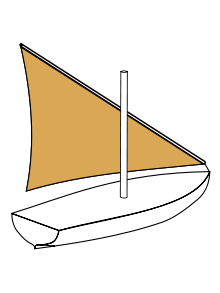
Dating back to Roman navigation, the lateen became the favorite sail of the Age of Discovery, mainly because it allows a boat to tack "against the wind". It is common in the Mediterranean and the northwestern parts of the Indian Ocean, where it is the standard rig for feluccas and dhows. The lateen is used today in a slightly different form on small recreational boats like the highly popular Sailfish and Sunfish, but is still used as a working rig by coastal fishermen in the Mediterranean.
History
Introduction into Mediterranean Sea
The earliest fore-and-aft rig was the spritsail, appearing in the 2nd century BC in the Aegean Sea on small Greek craft.[2] The lateen sail originated somewhat later during the Roman empire in the Mediterranean Sea.[2][3][4][5][6][7][8][9][10][11][12] It evolved out of the dominant square rig by setting the sails more fore-and-aft – along the line of the keel – rather than athwartship, while tailoring the luff and leech.[13]
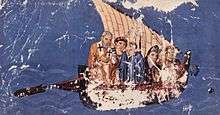
Both types of lateen were likely used from an early date on: a 2nd-century AD gravestone depicts a quadrilateral lateen sail (also known as a settee), while a 4th-century mosaic shows a triangular one which was to become the standard rig throughout the Middle Ages.[2] According to the Belgian maritime historian Lucien Basch, the true lateen rig appears as early as the 1st century BC, in a Hellenistic wall painting found in a Hypogeum in Alexandria.[15] The earliest archaeologically excavated ship that has been reconstructed with a lateen rig is dated to ca. 400 AD (Yassi Ada II), with a further four being attested prior to the Arab advance to the Mediterranean.[16] The Kelenderis ship mosaic (late 5th to early 6th century)[17][18] and the Kellia ship graffito from the early 7th century complement the picture.[18]
By the 6th century, the lateen sail had largely replaced the square sail throughout the Mediterranean, the latter almost disappearing from Mediterranean iconography until the mid-13th century.[19] It became the standard rig of the Byzantine dromon war galley and was probably also employed by Belisarius' flagship in the 532 AD invasion of the Vandal kingdom.[15][20] The fully triangular lateen and the settee continued to coexist in the middle Byzantine period, as evidenced by Christian iconography,[14] as well as a recent find of a graffito in the Yenikapı excavations.[21] In the 12th to 13th centuries the rigging underwent a change when the hook-shaped masthead made way for an arrangement more akin to a barrel-like crow's nest.[22]
After the Muslim conquests, the Arabs adopted the lateen sail by way of the Coptic populace, which shared the existing Mediterranean maritime tradition and continued to provide the bulk of galley crews for Muslim-led fleets for centuries to come.[23] This is also indicated by the terminology of the lateen among Mediterranean Arabs which is derived from Greco-Roman nomenclature.[24] More detailed research into their early use of the lateen is hampered by a distinct lack of unequivocal depictions of sailing rigs in early Islamic art.[25] A glazed pottery dish from Saracenic Dénia dating to the 11th century is at present the earliest securely identifiable example found in the Mediterranean.[25]
Nile River
From the Mediterranean, the lateen sail spread to the Nile River in Egypt, where the lateen-rigged felucca was developed.[26]
Diffusion to Indian Ocean
The emergence of new evidence for the development and spread of the lateen sail in the ancient Mediterranean in recent decades has led to a reevaluation of the role of Arab seafaring in the Indian Ocean in that process. Neither the attribution of the lateen to the Arabs nor its origin in the Indian Ocean can any longer be upheld:
The origin of the lateen sail has often been attributed by scholars to the Indian Ocean and its introduction into the Mediterranean traditionally ascribed to the Arab expansion of the early-7th century. This was due mainly to the earliest (at that time) iconographic depictions of lateen rigged ships from the Mediterranean post-dating the Islamic expansion into the Mediterranean basin...It was assumed that the Arab people who invaded the Mediterranean basin in the 7th century carried with them the sailing rig familiar to them. Such theories have been superseded by unequivocal depictions of lateen-rigged Mediterranean sailing vessels which pre-date the Arab invasion.[27][28]
Further inquiries into the appearance of the lateen rig in the Indian Ocean and its gulfs show a reversal of earlier scholarly opinion on the direction of diffusion, now pointing to an introduction by Portuguese sailors in the wake of Vasco da Gama's arrival in India in 1500.[29] Searches for lateen sails in India were inconclusive.[30] Since lateen sails were absent from Indian inland waters, that is in regions remote from foreign influences, as late as the mid-20th century, the hypothesis of an Indian origin appears a priori implausible.[31] The earliest evidence for the lateen in Islamic art adjacent to the Indian Ocean occurs in a 13th-century Egyptian artifact which, however, is assumed to show a Mediterranean vessel.[32] Excavated depictions of Muslim vessels along the Eastern African coast uniformly show square sails before 1500.[33] A recent discovering of a pot shred from Srilanka dating back to 3nd century BC shows triangular sail on a rigger.[34][35] A terracotta seal from Chandraketugarh according to J. Deloche may represent furled lateen sail.[36] Boats depicted in Chamardi rock cave painting dated to Maitraka dynasty from 5th century-7th century AD (but sometimes dated as late as 10th, 12th or 14th century) provides evidence of two Kotiya ships with lateen sail also with mounted rudder.[37] Fore and aft sail has also been depicted in Ajantha ship painting of 6th century AD.[38] According to archaeologist Daniel T Potts, An iron age pendant from Tell Abraq also shows one of the earliest depiction of lateen sails dated 1000-500 BC[39]
After 1500, the situation in the Indian Ocean dramatically changed, with nearly all vessels now being lateen rigged.[32] As Portuguese hull design and construction methods are known to have been subsequently adopted by Eastern Muslim shipbuilders, it is assumed that this process also included the lateen rigging of the novel caravel.[40] Within fourteen years of da Gama's arrival, lateens were spotted by the Portuguese on local vessels.[40]
Independent invention in South Seas
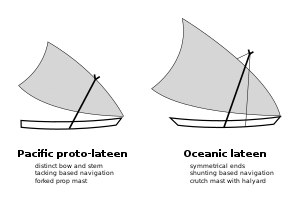
The "V"-shaped and mastless lateen rig, known as crab claw sail, of the seafaring people of Oceania, which was in use as far east as Tonga and Samoa at the time of European contact, is generally assumed to be an independent invention on the grounds of its very different construction.[41]
Later development

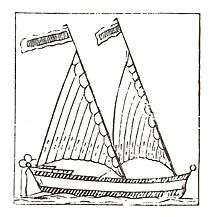
Until the 14th century, the lateen sail was employed primarily on the Mediterranean Sea, while the Atlantic and Baltic (and Indian Ocean) vessels relied on square sails. The Northern European adoption of the lateen in the Late Middle Ages was a specialized sail that was one of the technological developments in shipbuilding that made ships more maneuverable, thus, in the historian's traditional progression, permitting merchants to sail out of the Mediterranean and into the Atlantic Ocean; caravels typically mounted three or more lateens. However, the great size of the lateen yardarm makes it difficult and dangerous to handle on larger ships in stormy weather, and with the development of the carrack, the lateen was restricted to the mizzen mast. In the early nineteenth century, the lateen was replaced in European ships by the driver or spanker.
The lateen survived as a rigging choice for mainsails of small craft where local conditions were favorable. For instance, barge-like vessels in the American maritimes north of Boston, called gundalows, carried lateen rigs throughout the late nineteenth and early twentieth centuries. Likewise, lateen sail survived in the Baltic until the late 19th century. Because the yard pivots on its point of attachment to the mast, the entire sail and yard can be swiftly dropped. This was an advantage when navigating the tidal riverways of the region, which often required passage under bridges. The balancelle, a Mediterranean coasting and fishing boat of the 19th century, also used a single lateen sail.
One of the disadvantages of the lateen in the modern form described below is the fact that it has a "bad tack". The sail is to the side of the mast, on one tack that puts the mast directly against the sail on the leeward side, where it can significantly interfere with the airflow over the sail. On the other tack the sail is pushed away from the mast, greatly reducing the interference. On modern lateens, with their typically shallower angles, this tends to disrupt the airflow over a larger area of the sail.
However, there are forms of the lateen rig, as in vela latina canaria, where the spar is changed from one side to the other when tacking. This way the rig doesn't suffer these airflow disruptions that come from the sail pushed against the mast.[42]
The lateen sail can also be tacked by loosening the yard upper brace, tightening the lower brace until the yard is in vertical position, and twisting the yard on the other side of the mast by a tack. Another way of tacking with a lateen sail is to loosen the braces, lift the yard vertical, detach the sheet and tack, and turn the sail on the other side of the mast in front of the mast, and reattach the sheet and tack. This method is described in Björn Landström's The Ship.
The lateen rig was also the ancestor of the Bermuda rig, by way of the Dutch bezaan rig. In the 16th century, when Spain ruled the Netherlands, the lateen rigs were introduced to Dutch boat builders, who soon modified the design by omitting the mast and fastening the lower end of the yard directly to the deck, the yard becoming a raked mast with a full-length, triangular (leg-of-mutton) mainsail aft. Introduced to Bermuda early in the 17th century, this developed into the Bermuda rig, which, in the 20th century, was adopted almost universally for small sailing vessels.
Comparison to square rig
Square rig sails lie across the boat and catch a following wind well but are hard to set so that they can get drive when the boat is heading into the wind. By comparison a lateen or other fore and aft sail lies along the length of the boat and can be better controlled to enable the boat to sail to windward and is far more maneuverable, tacking and beating into the wind. Although a lateen sail is more difficult to tack with than the Marconi- or gaff rigs, it sail has a better aspect ratio than the square rig.
However, like most fore and aft sails the lateen runs poorly with a following wind. Thus, the Spaniards often re-rigged their vessels when they ventured out of the Mediterranean into the Atlantic, where the winds are constant and a square rig had the advantage.
Modern small-boat lateen sails

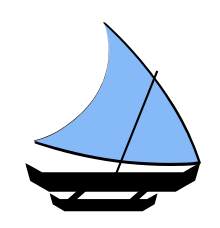
The modern lateen differs from traditional loose-footed lateens by the addition of a spar along the foot of the sail, similar to the crab claw sail traditionally used on the proa. The lower spar is horizontal, and is attached to the mast where it crosses. The front ends of both spars are joined together. Both joints are designed to allow free rotation in all directions. The sheet is attached to the lower spar, and the halyard to the upper spar. The geometry of the sail is such that the upper and lower spars are confined to a plane parallel to the mast. This results in the sail forming a conic section, identical to half of the Rogallo wing commonly found in kites and hang gliders.
The modern lateen is often used as a simple rig for catboats and other small recreational sailing craft. In its most basic form, it requires only two lines, a halyard and a sheet, making it very simple to operate. Often, additional lines are used to pull down the lower spar and provide tension along the upper and lower spars, providing greater control over the sail shape.
Since the upper and lower spars provide a frame for the sail, the camber of the sail is simply a function of how tightly the spars stretch the sail. This means that lateen sails are often cut flat, without the complex cutting and stitching required to provide camber in Bermuda rig sails. Curved edges, when mated with the straight spars, provide all or nearly all of the sail curvature needed.
See also
- Crab claw sail
- Tanja sail, a type of sail sometimes mistaken as lateen sail.
- Settee (a triangular sail with the front corner cut off)
Notes
- "the definition of lateen". Dictionary.com. Retrieved 3 April 2018.
- Casson 1995, pp. 243–245
- Casson 1954
- White 1978, p. 255
- Campbell 1995, pp. 8–11
- Basch 2001, pp. 63–64
- Makris 2002, p. 96
- Friedman & Zoroglu 2006, pp. 113–114
- Pryor & Jeffreys 2006, pp. 153–161
- Castro et al. 2008, pp. 1–2
- Whitewright 2009
- The tentative interpretation by Potts of a highly stylized stone engraving from Tell Abraq, UAE, dated sometime between 1000 and 500 BC, as an illustration of a lateen sail has found no acceptance with recent scholarship (Daniel T. Potts: Ancient Magan: The Secrets of Tell Abraq, 2000, Trident Press Ltd., p. 82 ISBN 978-1-900724-31-9). The isolated find would have predated the earliest attested occurrence of the lateen sail in the Indian Ocean by 2000-2500 years (White 1978, p. 255).
- Pryor & Jeffreys 2006, p. 153
- Whitewright 2009, p. 100
- Basch 2001, p. 63
- Castro et al. 2008, p. 352
- Pomey 2006
- Whitewright 2009, pp. 98f.
- Castro et al. 2008, p. 2
- Casson 1995, p. 245, fn. 82
- Günsenin & Rieth 2012, p. 157
- Whitewright 2009, p. 101
- Campbell 1995, pp. 9–10
- White 1978, pp. 256f.
- Whitewright 2012, p. 589
- Bisson, Wilfred J. (2020). "Introduction: Travel Technology". In Burns, William E. (ed.). Science and Technology in World History, Volume 1. ABC-CLIO. p. 226. ISBN 978-1-440-87116-0.
- Whitewright 2009, p. 98
- To the same effect: Casson 1954, pp. 214f.; Campbell 1995, pp. 7f.; White 1978
- White 1978
- White 1978, pp. 257f.
- White 1978, p. 257
- White 1978, p. 258
- White 1978, p. 259
- Weisshaar, Hans-Joachim. Hans-Joachim Weisshaar / Helmut Roth / W. Wijeyapala (eds.), Ancient Ruhuna. Sri Lankan – German Archaeological Project in the Southern Province, Vol. 1 (= Materialien zur Allgemeinen und Vergleichenden Archäologie, Band 58). Mainz: Philipp von Zabern. p. 16.
- AN ANCIENT IRON CARGO IN THE INDIAN OCEAN: THE GODAVAYA SHIPWRECK
- Barnes, Ruth; Parkin, David (2015-12-22). Ships and the Development of Maritime Technology on the Indian Ocean. Routledge. ISBN 978-1-317-79342-7.
- Rock Art
- Schlingloff, Dieter (1976). "Kalyāṇakārin's Adventures. The Identification of an Ajanta Painting". Artibus Asiae. 38 (1): 5–28. doi:10.2307/3250094. ISSN 0004-3648.
- Potts, Daniel T. (2000). Ancient Magan: The Secrets of Tell Abraq. Trident Press Ltd. p. 82. ISBN 978-1-900724-31-9.
- White 1978, p. 260
- Campbell 1995, pp. 11–18
- "YouTube". www.youtube.com. Retrieved 3 April 2018.
Sources
- Basch, Lucien (2001), "La voile latine, son origine, son évolution et ses parentés arabes", in Tzalas, H. (ed.), Tropis VI, 6th International Symposium on Ship Construction in Antiquity, Lamia 1996 proceedings, Athens: Hellenic Institute for the Preservation of Nautical Tradition, pp. 55–85
- Campbell, I.C. (1995), "The Lateen Sail in World History" (PDF), Journal of World History, 6 (1), pp. 1–23, archived from the original (PDF) on 2016-08-04, retrieved 2009-10-08
- Casson, Lionel (1954), "The Sails of the Ancient Mariner", Archaeology, 7 (4), pp. 214–219
- Casson, Lionel (1995), Ships and Seamanship in the Ancient World, Johns Hopkins University Press, ISBN 978-0-8018-5130-8
- Castro, F.; Fonseca, N.; Vacas, T.; Ciciliot, F. (2008), "A Quantitative Look at Mediterranean Lateen- and Square-Rigged Ships (Part 1)", The International Journal of Nautical Archaeology, 37 (2), pp. 347–359, doi:10.1111/j.1095-9270.2008.00183.x
- Friedman, Zaraza; Zoroglu, Levent (2006), "Kelenderis Ship. Square or Lateen Sail?", The International Journal of Nautical Archaeology, 35 (1), pp. 108–116, doi:10.1111/j.1095-9270.2006.00091.x
- Günsenin, Nergis; Rieth, Éric (2012), "Un graffito de bateau à voile latine sur une amphore (IXe s. ap. J.-C.) du Portus Theodosiacus (Yenikapı)", Anatolia Antiqua, 20, pp. 157–164
- Makris, George (2002), "Ships", in Laiou, Angeliki E (ed.), The Economic History of Byzantium. From the Seventh through the Fifteenth Century, 1, Dumbarton Oaks, pp. 89–99, ISBN 978-0-88402-288-6
- Pomey, Patrice (2006), "The Kelenderis Ship: A Lateen Sail", The International Journal of Nautical Archaeology, 35 (2), pp. 326–335, doi:10.1111/j.1095-9270.2006.00111.x
- Pryor, John H.; Jeffreys, Elizabeth M. (2006), The Age of the ΔΡΟΜΩΝ: The Byzantine Navy ca. 500–1204, Brill Academic Publishers, ISBN 978-90-04-15197-0
- White, Lynn (1978), "The Diffusion of the Lateen Sail", Medieval Religion and Technology. Collected Essays, University of California Press, pp. 255–260, ISBN 978-0-520-03566-9
- Whitewright, Julian (2009), "The Mediterranean Lateen Sail in Late Antiquity", The International Journal of Nautical Archaeology, 38 (1), pp. 97–104, doi:10.1111/j.1095-9270.2008.00213.x
- Whitewright, Julian (2012), "Early Islamic Maritime Technology", in Matthews, R.; Curtis, J.; Gascoigne, A. L. (eds.), Proceedings of the 7th International Congress on the Archaeology of the Ancient Near East. Volume 2: Ancient & Modern Issues in Cultural Heritage, Colour & Light in Architecture, Art & Material Culture, Islamic Archaeology, Wiesbaden: Harrassowitz Verlag, pp. 585–598
Further reading
- Rousmaniere, John (June 1998). The Illustrated Dictionary of Boating Terms: 2000 Essential Terms for Sailors and Powerboaters (Paperback). W. W. Norton & Company. pp. 174. ISBN 0393339181. ISBN 978-0393339185
- Whitewright, Julian (2011), "The Potential Performance of Ancient Mediterranean Sailing Rigs", The International Journal of Nautical Archaeology, 40 (1), pp. 2–17 (9–14)
- Rousmaniere, John (June 1998). The Illustrated Dictionary of Boating Terms: 2000 Essential Terms for Sailors and Powerboaters (Paperback). W. W. Norton & Company. pp. 174. ISBN 0393339181. ISBN 978-0393339185
External links
| Wikimedia Commons has media related to Lateen. |
- The ship's development during the Middle Ages, see bottom of page for English translation
- PolySail International instructions for building a Sunfish-like lateen sail
- I. C. Campbell, "The Lateen Sail in World History", Journal of World History (University of Hawaii), 6.1 (Spring 1995), p. 1–23